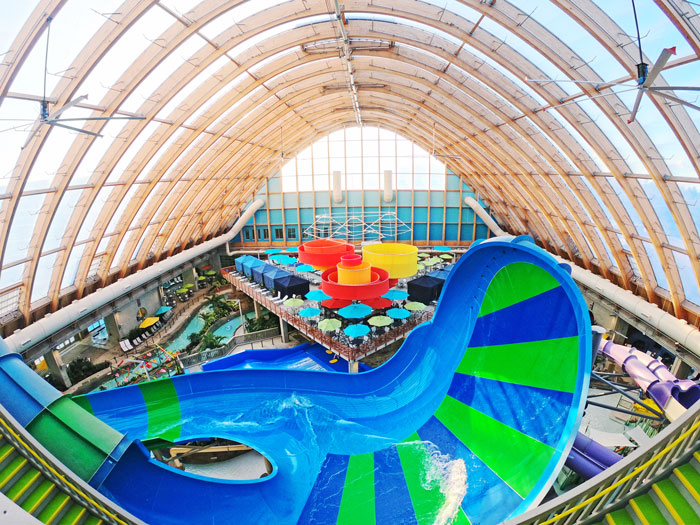It’s January in the Midwest, and the family needs a break from snow and cold. Or, it’s August in the south, and the family needs a break from relentless heat. Or, it’s any time of year and the adults need a break from kids and work. Innovations in indoor waterparks and facilities mean a tropical wilderness or tranquil paradise awaits somewhere in North America.
Waterpark owners and operators have been taking technological improvements, experience and boundless creativity to new levels for indoor fun at any time of year. These innovations are being spurred on by a public that is keenly aware of what is available to their family and friends who live hundreds of miles away, and want to find a little bit of that fun closer to home.
“Our culture is tied together through social media and a continuous feed of exciting and beautiful locations and attractions,” said Jason Sorci, partner, president and chief financial officer of architectural design company ADCI. “It has exposed the public to many experiences that they would otherwise have been unable to engage in, and has made guests much more design-savvy and raised their expectations substantially.”
Waterparks are “an evolving, growing field,” said Nancy Patterson, director of design and business development at an Ontario, Canada-based manufacturer of retractable roof structures—commonly deployed in indoor waterpark facilities. She cited guests’ desires along with financial and operational improvements that allow facility managers and aquatic designers and manufacturers to dream big.
Meeting Expectations
Seeing your cousin’s visit to a ski lodge with a glass-roofed waterpark on Instagram gives you more ideas for your own experience. Beyond the family demographic, aquatic experiences can extend to areas not just themed for grownups, but perhaps restricted to them, as in a spa or a separate pool serving adult beverages.
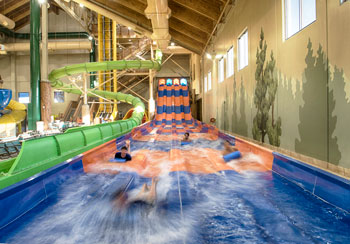
“Guests are looking for a strong and unique experience,” Sorci said. “In the past this was met through employing theming that was really geared toward children. Parents were happy when the kids were happy. Today (parents) want an experience that also caters to them. This has culminated in limited, more targeted theming and a higher level of interior finish. This also ties into amenity choice and having amenities that serve adults.” For example, Sorci said, swim-up bars can provide a popular adults-only amenity.
No one wants to spend precious vacation time in the dank, humid waterpark sheds from last century. Design materials have become so sophisticated that retractable glass roofs are within reach for almost all aquatic facilities, and each waterpark can have settings, decor and materials that reflect their part of the world and hold up under the wear and tear of the aquatic environment, from wet bathing suits, excited children and spilled margaritas to the more humid, potentially corrosive air.
“There continues to be a desire to bring the outdoors in and utilize natural elements. And while there is a strong influx of what AI can and will do with 3-D capabilities and virtual reality, there is still some desire for minimalism, to step away from the everyday fast life,” said Todd Frawley, partner and vice president of ADCI’s Lake Delton, Wis., operations.
ADCI’s work on Sundara, a renowned spa in the Wisconsin Dells, included materials that mimic the glacier-carved sandstone outcroppings that made the area famous in the first place.
So how do owners and managers make everyone happy? The pros know.
“No two projects, owners, markets or properties are exactly alike, which requires a unique approach to each. Often, a project owner comes with a core idea: ‘I love this. I want to do this.’ We take that core idea, study it, lay it out, develop a design and aesthetic, and connect the operational components to it,” said Sorci.
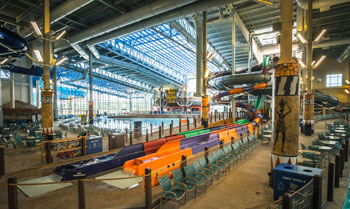
“We work with clients to establish a program based on their feasibility studies. From there, we develop the master plan that is best suited for the site while working with the topography and orientation to take advantage of sun angles for the various amenities being offered.”
Sorci explained that these items help establish the footprint of the building. Designers then turn to 3-D massing to establish the overall shape and appearance of the building.
“From an interior perspective, we focus on the arrival experience all the way through the resort,” said Frawley. “This helps the facility owners and operators visualize how it can help them meet financial or programmatic goals, and make sense and be exciting to the guest.”
“Once we get a program from a client and hear what their vision is, we use a mixture of inspiration photos from past projects along with 3-D diagrammatic models of building concepts to help them visualize the completed project,” said Jason Ryan, partner and architect with ADCI.
Giving Your Park a Glow Up
Existing aquatic facilities already have fans who don’t want their favorite parks to change too much. Legacy parks may have helped families make memories for decades, but they can’t tread water with designs and amenities that have been in place for years. Renovations can kickstart a new era by attracting new customers—and perhaps correcting issues such as mold, leaks or bad ventilation.
“The first place to start is by recognizing the invested value that’s already in place. Then ask, ‘What are our needs and opportunities? How do we leverage our investment?’” said Sorci.
“A waterpark added to an existing hotel can be a tremendous enhancement. However, these are rarely simple projects, and they require both big investments of capital as well as a big investment in time, education and maintenance from facility operations,” he said.
Sorci added that invested value includes the guests who have been coming for years, as well as park staff.
“The various lines of business within a facility need to be aligned and understand the adjustments that may come with any new amenity. For a business hotel, the addition of a waterpark is inevitably going to mix swimsuits with business suits. This impact to the legacy guest should be planned for and mitigated and not come as a surprise after opening.”
And if there are surprises, they should enhance the experience for everyone. “Creating a sense of discovery for your patrons while they stay at your facility will keep them engaged in what you have to offer. While curb appeal is nice, if the guests know an amenity is there, they will find it,” said Ryan.
But facilities need the right amenities aimed at the guests who are looking for them.
“We use our experience and knowledge of the guest demographics and local markets to recommend amenities that enhance and reinforce each other and lay them out in a way that they increase guest impulse spending,” said Sorci. This means a renovated waterpark can benefit from shops, golf, restaurants and arcades to get guests to stay and spend.
Frankenmuth, Mich., is a popular Midwestern destination, known for its Bavarian architecture, for the world’s largest year-round Christmas store and for family-style chicken dinners at Zehnder’s. Staying and playing at Zehnder’s Splash Village Hotel and Waterpark has also become part of many long weekends.
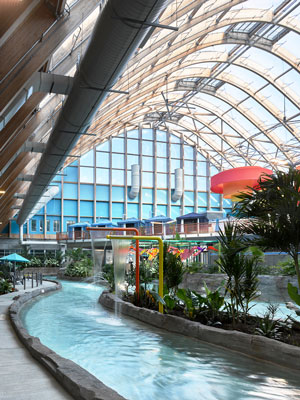
This got-it-all attraction started as a roadside restaurant but really took off in 1988 when Zehnder’s purchased Bavarian Haus Motel. In 2004, a section of the original building was demolished to make room for 30,000 square feet of indoor waterpark, arcade, dining and family suites. Nearly 10 years later, an additional atrium waterpark, and rooms with views of the action, were added.
Patterson recalled that the very popular new park prompted a hard look at the old park. “They found that the entire walls and roof were black mold,” she said. By contrast, the wood structure, which was actually laminated wood, that was attached to the old park was still in good shape. Patterson’s company created a retractable roof and clear walls for Zehnder’s, which now advertises “Over 50,000 Square Feet of Aquatic Fun Indoors.”
Not Your Father’s Dark Shed
Zehnder’s tagline (if not all that square footage) could be the goal of waterpark managers everywhere. All you need is some indoor space, and operable roofs have made it simpler to transition outdoor spaces to indoor.
“Operable glass roofscapes or EFTE roofs in waterparks are becoming very popular,” said Ryan. ETFE is ethylene tetrafluoroethylene, a plastic designed to have high corrosion resistance and strength over a wide temperature range.
“People enjoy the feeling of being outside no matter what the weather is like. Spaces that allow easy transition from indoors to outdoors are very popular as well,” he said.
But it’s important to work with companies and designers experienced with indoor waterparks, or your beautiful enclosure could become a problem.
“Corrosion in waterparks is a massive issue,” Patterson said. Years of spray and mist from the activities inside and weather outside mean a traditional steel roof might need to be replaced in eight to 10 years. Patterson described how some water conservation efforts in parks effectively helped eat away at the buildings they were in, as reformulated waterplay tubes led to more spray.
That’s why the structural portions of the operable roofs Patterson’s company manufactures are 100% aluminum, as are all of the slide tower supports and railings.
“Aluminum is a much more refined material,” Patterson said, adding that its only corrosion risk is with salt air.
Aluminum is lighter and better able to handle the waterpark environment. Steel can be treated to make it more comparable in terms of corrosion resistance, but Patterson noted that by the time you treat steel to be able to handle a waterpark environment, it’s not much cheaper than aluminum.
Guests might not know the difference between a state-of-the-art retractable roof and an old-fashioned greenhouse, but the facility manager does. Part of the learning curve of retractable roofs is knowing how to use them to the facility’s advantage. Unlike greenhouses, retractable roofs are “thermally broken” sealed spaces, meaning there is no energy transfer through the walls. So, for example, said Patterson, “you have to open as much of the roof as possible to get the effects of the retractable roof.”
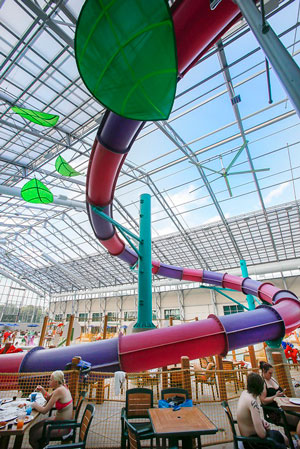
Retractable roofs can save energy and its associated costs and help with air quality in the aquatic area, Patterson said. Even in northern climates, the roof can open as early in the year as April and open at any time through the fall. When the roof is open, indoor and outdoor temperatures move to equalize, allowing outdoor air to do the HVAC work with just the fans and air handlers for air flow. Or, if you can let the breezes manage your air flow and the sun provide your illumination, Patterson estimates a savings in energy costs of 20% to 30% per year.
The climate outside of Tropic Falls Waterpark near the Gulf Coast in Alabama experiences a lot of heat and rain. There, Patterson said, the roof opens and closes depending on the precipitation, but the walls can be open all day, which cuts down on humidity and keeps the place cooler. Guests are having a great time no matter what’s going on outside.
Selling the Splash
“The successful design of destination properties requires a critical mass of amenities to create a sense of discovery that engages and excites guests,” said Sorci. “Too little variety will hurt average length of stay and ancillary revenue. Too many amenities can burden a project development budget, duplicate already existing offerings in the larger market, or cannibalize sales with internal competition. We work as a team with our client to find the right balance.”
“Observe and listen to what your target clients enjoy and want, rather than following what the industry is doing. Once you have that nailed down, engage design professionals early to see how your facility can best achieve your goal,” added Frawley.
“Be thoughtful, deliberate, sober and find the right people to help you through the process,” Sorci said.
If your facility is done right, guests will discover that your corner of paradise is a multi-seasonal destination.
“This is a space where you can spend the entire day,” said Patterson. RM



